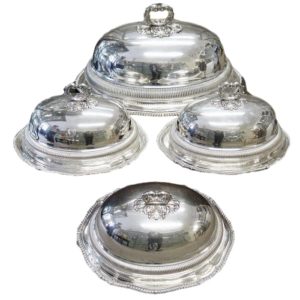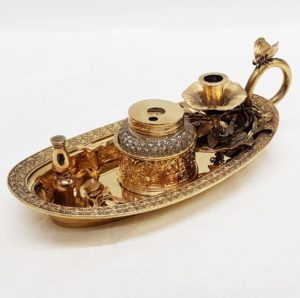John Bridge
John Bridge, London goldsmith, apprenticed 1769 to William Rogers of Bath. Arrived in London aged 22 and became shopman at Pickett and Rundell, forming a partnership with Philip Rundell circa 1788. Rundell & Bridge manufactured exquisite goods in precious and semi-precious materials, dealing in silver and silver-gilt, diamond and pearls and all manner of jewellery, gold boxes, watches and objects of vertue and the two were appointed Goldsmiths and Jewellers to the King circa 1797 and the royal warrant continued until 1843. Rundell’s nephew Edmund Waller Rundell joined them in 1805 when they became known as Rundell, Bridge & Rundell. Paul Storr worked with them from 1807 until he left to form his own business in 1819. John Bridge’s first mark alone was registered as plateworker (4 sizes) in 1823 after the retirement of Philip Rundell. 2nd mark (3 sizes) 1823. Bridge’s nephew John Gawler Bridge became partner in 1827 having joined the business in 1804, free by redemption 1816, Livery 1818, Court 1831, Prime warden 1839. In 1830 Bridge formed a new firm with his nephew and Thomas Bigge which lasted until 1834. In 1842 the firm was liquidated.
Among their many prestigious commissions the business was responsible for the Crown Jewels used at the coronations of George IV, William IV and Queen Victoria, as well as the wide range of banqueting plate and jewellery now in the Royal Collection.
John Bridge
John Bridge, London goldsmith, apprenticed 1769 to William Rogers of Bath. Arrived in London aged 22 and became shopman at Pickett and Rundell, forming a partnership with Philip Rundell circa 1788. Rundell & Bridge manufactured exquisite goods in precious and semi-precious materials, dealing in silver and silver-gilt, diamond and pearls and all manner of jewellery, gold boxes, watches and objects of vertue and the two were appointed Goldsmiths and Jewellers to the King circa 1797 and the royal warrant continued until 1843. Rundell’s nephew Edmund Waller Rundell joined them in 1805 when they became known as Rundell, Bridge & Rundell. Paul Storr worked with them from 1807 until he left to form his own business in 1819. John Bridge’s first mark alone was registered as plateworker (4 sizes) in 1823 after the retirement of Philip Rundell. 2nd mark (3 sizes) 1823. Bridge’s nephew John Gawler Bridge became partner in 1827 having joined the business in 1804, free by redemption 1816, Livery 1818, Court 1831, Prime warden 1839. In 1830 Bridge formed a new firm with his nephew and Thomas Bigge which lasted until 1834. In 1842 the firm was liquidated.
Among their many prestigious commissions the business was responsible for the Crown Jewels used at the coronations of George IV, William IV and Queen Victoria, as well as the wide range of banqueting plate and jewellery now in the Royal Collection.
-


1831
John Bridge
9134 Antique Silver Meat Dishes with Dome Covers
£16,500
This is a stunning lot. A fine graduated set of William IV sterling silver meat dishes. Oval form with gadrooned borders. Previously owned by the Maitland* family, all pieces bearing the Maitland arms. Each dish has a hand engraved coat of arms on opposite edges. The dishes are mounted with a graduated set of matching Old Sheffield plated meat dish covers of plain oval outline with fluted borders and detachable handle. Each dome is hand engraved with a crest on one side and a coat of arms on the other. The complete set is contained in a fitted, iron-bound oak trunk. Excellent weight and gauge of silver. Weight of the four silver meat dishes 9858 grams, 317 troy ounces approx. The platters measure large – 61 x 44 cm, medium – 50 x 39 cm and 2 small platters 42 x 32.5 cm. Sterling silver platters made by John Bridge, London 1831. Old Sheffield plate domes marked for Matthew Boulton.
-


1825
John Bridge
9342 George IV Antique Silver Inkstand
Sold
An exquisite antique silver inkstand by the master craftsman John Bridge. Sterling silver with the original bright gilt finish. All contained within a boat shaped dish, this charming piece has a carrying handle surmounted by a model bee. The cut crystal inkwell sits within a decorative raised gallery, the candle holder is formed as a flower raised on a leafy stalk, and the candle snuffer nestles alongside a second flower tendril. Excellent fine quality. Weight 542 grams, 17.4 troy ounces. Height 7.8 cm. Spread 20.5 cm. Top 18.5 x 10 cm. London 1825. By the prestigious John Bridge, royal goldsmith to King George III and IV.